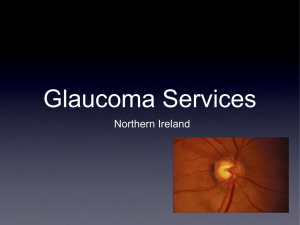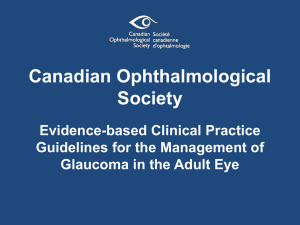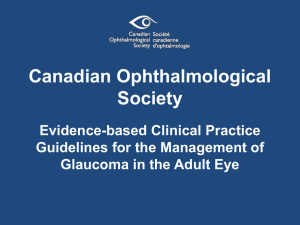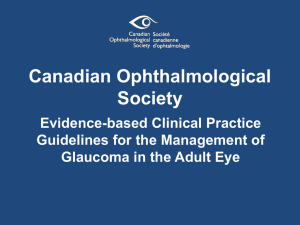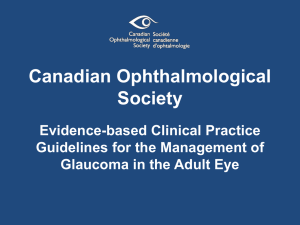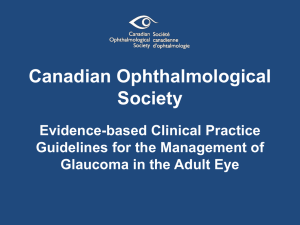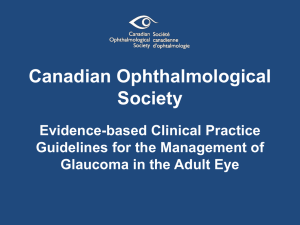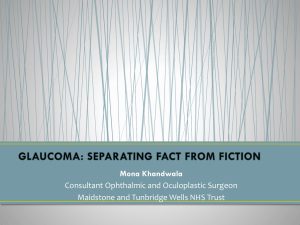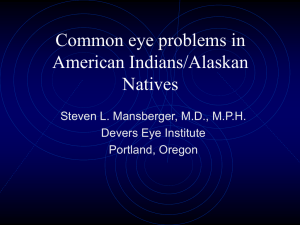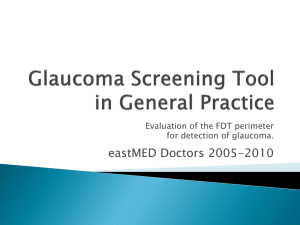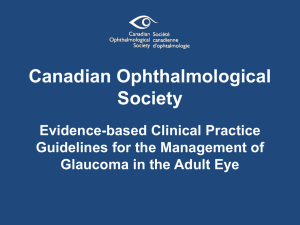Imaging and perimetry - Canadian Ophthalmological Society
advertisement
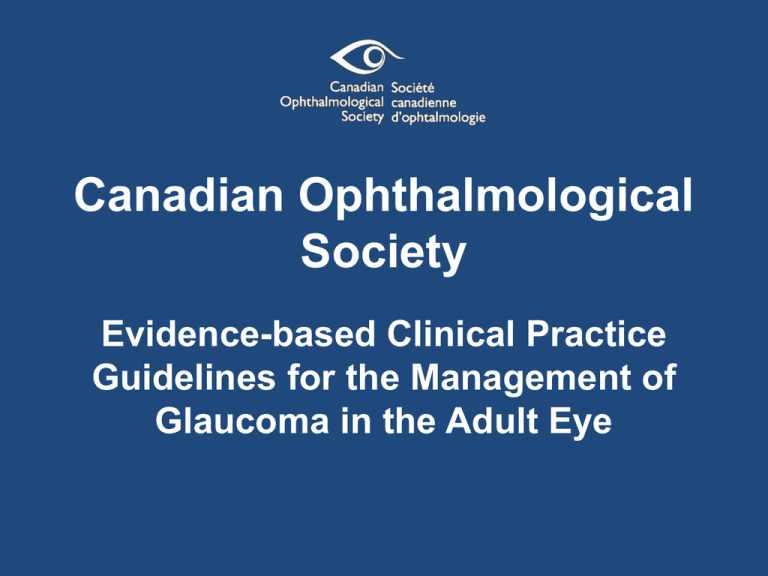
Canadian Ophthalmological Society Evidence-based Clinical Practice Guidelines for the Management of Glaucoma in the Adult Eye Role of Imaging Devices in Monitoring Glaucoma Merits and limitations of ONH and RNFL analyzers and optic disc/RNFL photography Analysis method ONH photography RNFL photography Merits Limitations* • Evaluated in clinical trials and long clinical experience • Established technique that will not change over time • Excellent for educational purposes • Allows evaluation of details such as presence of disc hemorrhage • Useful as baseline even after cataract surgery • Early detection of structural changes • Subjective interpretation dependent on clinical expertise • Poor agreement among experts in diagnosis and detection of change • Poorly tolerated by patients, usually requiring pupil dilation • Requires highly trained photographer *Some limitations to all techniques include the lack of widespread availability to the non-specialist, high price of the devices, and lack of consensus on how to interpret the findings for diagnosis and progression. Canadian Ophthalmological Society evidence-based clinical practice guidelines for the management of glaucoma in the adult eye. Can J Ophthalmol 2009;44(Suppl 1):S1S93. Merits and limitations of ONH and RNFL analyzers and optic disc/RNFL photography (cont’d) Analysis method CSLT Merits Limitations* • Long track record, stable technology • Diagnostic and progression software available and tested in clinical studies • Easy to acquire images through undilated pupils • Simultaneous evaluation of ONH and RNFL parameters • Easy-to-read printouts and interactive software (useful for progression) • Portable device (HRT 3) • Relatively low specificity for screening situations • Sometimes influenced by cataract surgery • Progression analysis not yet fully validated in longterm studies • Difficult to detect optic disc hemorrhages • Relatively limited RNFL analysis *Some limitations to all techniques include the lack of widespread availability to the non-specialist, high price of the devices, and lack of consensus on how to interpret the findings for diagnosis and progression. Canadian Ophthalmological Society evidence-based clinical practice guidelines for the management of glaucoma in the adult eye. Can J Ophthalmol 2009;44(Suppl 1):S1S93. Merits and limitations of ONH and RNFL analyzers and optic disc/RNFL photography (cont’d) Analysis Merits method SLP • Easy to acquire images through undilated pupils • Large normative database • Good specificity in most studies • Easy-to-read printouts OCT • • • • Limitations* • Evolving technology • Indirect measurement of RNFL • Restricted to RNFL evaluation • Lack of validated progression analysis High axial resolution • Sometimes requires pupil Allows evaluation of RNFL and dilation ONH • Evolving technology Large normative database • Lack of validated Easy-to-read printouts progression analysis • Nonportable device *Some limitations to all techniques include the lack of widespread availability to the non-specialist, high price of the devices, and lack of consensus on how to interpret the findings for diagnosis and progression. Canadian Ophthalmological Society evidence-based clinical practice guidelines for the management of glaucoma in the adult eye. Can J Ophthalmol 2009;44(Suppl 1):S1S93. Documentation of the optic disc Recommendation Baseline and sequential documentation of the status of the optic disc are essential in the management of ocular hypertension and glaucoma and should be performed with photographs and (or) with ONH and RNFL analyzers [Level 113]. 1. Collaborative Normal-Tension Glaucoma Study Group. Am J Ophthalmol 1998;126:487–97. 2. Kass MA, et al. Arch Ophthalmol 2002;120:701–13. 3. Heijl A, B, et al. Arch Ophthalmol 2002;120:1268–79. Canadian Ophthalmological Society evidence-based clinical practice guidelines for the management of glaucoma in the adult eye. Can J Ophthalmol 2009;44(Suppl 1):S1S93. Role of Psychophysical Tests in Monitoring Glaucoma Merits and limitations of manual perimetry, SAP, SWAP, and FDT Perimetry Type Advantages Disadvantages Manual (i.e., Goldmann) • Long track record • Easier to do than SAP • Nonstandardized • Well-trained technician required SAP • Quantitative and standardized algorithms • Diagnostic and progression statistics available • Expensive and nonportable equipment SWAP • May detect defects and change earlier than SAP • More influenced by cataract FDT • Sensitive to early changes • Good patient acceptance • Portable — screening tool • No progression software available Canadian Ophthalmological Society evidence-based clinical practice guidelines for the management of glaucoma in the adult eye. Can J Ophthalmol 2009;44(Suppl 1):S1S93. Appendix C: Field progression Figure 1—New scotoma Copyright © 2008 SEAGIG, Sydney. Reproduced with permission from Asia Pacific Glaucoma Guidelines, 2nd ed. Hong Kong: Scientific Communications, 208:1-117. Canadian Ophthalmological Society evidence-based clinical practice guidelines for the management of glaucoma in the adult eye. Can J Ophthalmol 2009;44(Suppl 1):S1S93. Appendix C: Field progression Figure 2—Deepening scotoma Copyright © 2008 SEAGIG, Sydney. Reproduced with permission from Asia Pacific Glaucoma Guidelines, 2nd ed. Hong Kong: Scientific Communications, 208:1-117. Canadian Ophthalmological Society evidence-based clinical practice guidelines for the management of glaucoma in the adult eye. Can J Ophthalmol 2009;44(Suppl 1):S1S93. Appendix C: Field progression Figure 3—Deepening and enlarging scotoma Copyright © 2008 SEAGIG, Sydney. Reproduced with permission from Asia Pacific Glaucoma Guidelines, 2nd ed. Hong Kong: Scientific Communications, 208:1-117. Canadian Ophthalmological Society evidence-based clinical practice guidelines for the management of glaucoma in the adult eye. Can J Ophthalmol 2009;44(Suppl 1):S1S93. Visual field testing in glaucoma Recommendation It is recommended that SAP be used as the standard for VF testing for glaucoma diagnosis and monitoring. A testing strategy such as SITA Standard is recommended as the preferred choice for following patients with glaucoma, while SITA Fast could be considered for screening and diagnosis [Level 31]. Newer psychophysical tests such as SWAP and FDT perimetry technology might be useful in some cases [Level 32], but their role in glaucoma management has not been fully assessed. 1. Artes PH, et al. Invest Ophthalmol Vis Sci 2002;43:2654–9. Canadian Ophthalmological Society evidence-based clinical practice guidelines for the management of glaucoma in the adult eye. Can J 2. Artes PH, et al. Invest Ophthalmol Vis Sci 2005;46:2451–7. Ophthalmol 2009;44(Suppl 1):S1S93. Role of Neuroimaging in Glaucoma Diagnosis Neuroimaging in glaucoma Recommendation Neuroimaging is not routinely indicated in cases of glaucoma, including NPG, and should be reserved for patients in whom the disc and VF findings do not correlate and (or) are not consistent with glaucomatous damage [Consensus]. Canadian Ophthalmological Society evidence-based clinical practice guidelines for the management of glaucoma in the adult eye. Can J Ophthalmol 2009;44(Suppl 1):S1S93.

